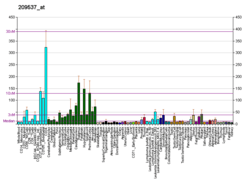EXTL2
Exostosin-like 2 is a protein that in humans is encoded by the EXTL2 gene.[5][6][7]
References
- 1 2 3 GRCh38: Ensembl release 89: ENSG00000162694 - Ensembl, May 2017
- 1 2 3 GRCm38: Ensembl release 89: ENSMUSG00000027963 - Ensembl, May 2017
- ↑ "Human PubMed Reference:".
- ↑ "Mouse PubMed Reference:".
- ↑ Wuyts W, Van Hul W, Hendrickx J, Speleman F, Wauters J, De Boulle K, Van Roy N, Van Agtmael T, Bossuyt P, Willems PJ (Mar 1998). "Identification and characterization of a novel member of the EXT gene family, EXTL2". Eur J Hum Genet. 5 (6): 382–9. PMID 9450183.
- ↑ Sobhany M, Dong J, Negishi M (Jun 2005). "Two-step mechanism that determines the donor binding specificity of human UDP-N-acetylhexosaminyltransferase". J Biol Chem. 280 (25): 23441–5. doi:10.1074/jbc.M413379200. PMID 15831490.
- ↑ "Entrez Gene: EXTL2 exostoses (multiple)-like 2".
Further reading
- Ota T, Suzuki Y, Nishikawa T, et al. (2004). "Complete sequencing and characterization of 21,243 full-length human cDNAs". Nat. Genet. 36 (1): 40–5. doi:10.1038/ng1285. PMID 14702039.
- Strausberg RL, Feingold EA, Grouse LH, et al. (2003). "Generation and initial analysis of more than 15,000 full-length human and mouse cDNA sequences". Proc. Natl. Acad. Sci. U.S.A. 99 (26): 16899–903. doi:10.1073/pnas.242603899. PMC 139241. PMID 12477932.
- McCormick C, Duncan G, Goutsos KT, Tufaro F (2000). "The putative tumor suppressors EXT1 and EXT2 form a stable complex that accumulates in the Golgi apparatus and catalyzes the synthesis of heparan sulfate". Proc. Natl. Acad. Sci. U.S.A. 97 (2): 668–73. doi:10.1073/pnas.97.2.668. PMC 15388. PMID 10639137.
- Kitagawa H, Shimakawa H, Sugahara K (1999). "The tumor suppressor EXT-like gene EXTL2 encodes an alpha1, 4-N-acetylhexosaminyltransferase that transfers N-acetylgalactosamine and N-acetylglucosamine to the common glycosaminoglycan-protein linkage region. The key enzyme for the chain initiation of heparan sulfate". J. Biol. Chem. 274 (20): 13933–7. doi:10.1074/jbc.274.20.13933. PMID 10318803.
- Saito T, Seki N, Yamauchi M, et al. (1998). "Structure, chromosomal location, and expression profile of EXTR1 and EXTR2, new members of the multiple exostoses gene family". Biochem. Biophys. Res. Commun. 243 (1): 61–6. doi:10.1006/bbrc.1997.8062. PMID 9473480.
- Bonaldo MF, Lennon G, Soares MB (1997). "Normalization and subtraction: two approaches to facilitate gene discovery". Genome Res. 6 (9): 791–806. doi:10.1101/gr.6.9.791. PMID 8889548.
This article is issued from
Wikipedia.
The text is licensed under Creative Commons - Attribution - Sharealike.
Additional terms may apply for the media files.




